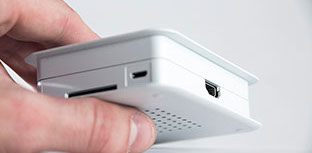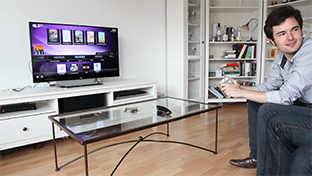Extra-curricular activity - 2013/2014
Smallplayer
In the beginning of summer 2013 a friend came to me with an idea for a media player. Together we develop the concept of Smallplayer, based on the open source software XBMC and from November 2013 people were able to buy the product. (see www.smallplayer.nl) My contribution to this project is mainly focused on the user experience, including communication, interface and interaction design.
Communication of the real, the authenticity
From the start of the project it is a constant search to what identity Smallplayer has and how to communicate this to your potential user. At first I tried to communicate the vision of what you would like to achieve, but I learned that only communicating the vision of the company and the features of the product doesn’t explain the identity of Smallplayer yet. This style of communication is something that I learned within Industrial Design, because here you need to communicate your ambitions and plans towards stakeholders of the project and often not the users. If the goal is to get customers and make them stick to your company, you need to communicate the authenticity of the product and therefore tell the real story about what Smallplayer is. If what you communicate doesn’t really match with what customers get, they get confused or unsatisfied and have a bad experience. The actual goal here is not to just sell a product, but to gain the support of your users, which allows you the freedom to develop the product further on, even with input from the users themselves.
My role: Bridging gap between user and technology
The qualities of the study Industrial Design is that you learn to work in multi-disciplinary teams and gaining knowledge about technology and the user’s perspective. I learned that these qualities are very much reflected in my work with Smallplayer. My companion takes care of which functionalities are integrated in Smallplayer, but integrates these functionalities in a way that suits him the best. Since he has much more knowledge and experience of the technology, his perspective of how the features of Smallplayer should be implemented is different then the perspective of the user. Since I have lesser experience in working with this technology, but enough to understand the possibilities and do have experience in design from a user’s perspective, I am bridging the gap between user and technology.
Design and business perspective
When I created “de Jongens van de TU” in 2011, we created a company that basically offered design as a business-to-business service for assignments in communication, such as web-design. Smallplayer however is a totally different company. We sell products to consumers, where the revenue is based on a mass-productive strategy. My goal as a designer is to create a product with the highest quality and the best user experience. The goal of my companion, who is working from a business perspective, is to gain to most money to keep the company running. It was very interesting to work with these two perspectives and always finding a way that would suit both perspectives. I learned that you cannot always offer the quality that you would wish to offer from a design perspective, for example developing a self designed casing. With Smallplayer we had to choose an existing casing, since creating a self-designed casing would require a too large investment. We found a compromise in altering the existing cases so it could still express the identity of Smallplayer, by for example printing a logo on the case. The challenge for a designer in start-ups is to find low-cost solutions from a design perspective.
User testing – a clash with the real world
I also learned that when we are creating a product that should be sold in reality, it is harder to dare less-traditional approaches or making radical choices that you would have applied in a study project. If you fail during a study project, you can reflect on this and learn from it. If you fail during a Smallplayer, than you might loose it all. Or so I thought at first. Due to the integration of Smallplayer within my study project I was more forced implement less-traditional approaches such as co-reflection. The experience of this co-operation with our users and me turned out very fruitful for future improvement and established a good relationship to work together in the future. It is good to see that the methods that I learn here at the faculty can be well implemented in real-life business ideas, which also gives even more confidence in my own expertise.
Overall
Smallplayer has been the mirror for my study that reflects the real world back on the things that I learn at the faculty. I learned how to deal with things like (production) time and costs, things that I did not came across yet in my study. I learned to work closely together with other disciplines and experts, whose perspectives on things can be fundamentally different. And I learned implement methods I learned during my study that might seem strange to others at first. Overall Smallplayer has showed me a new (business) perspective of design.

